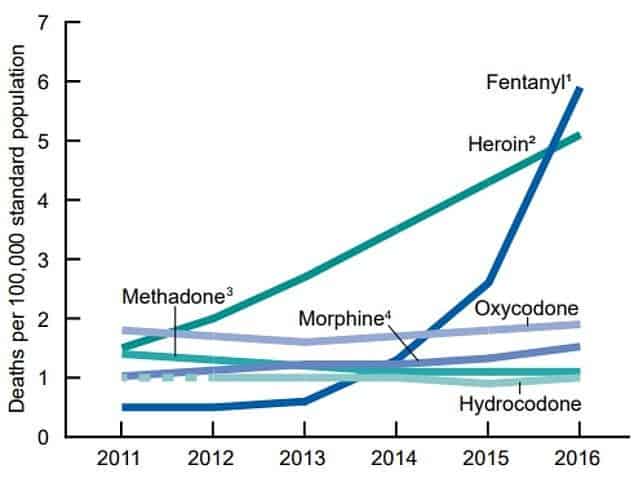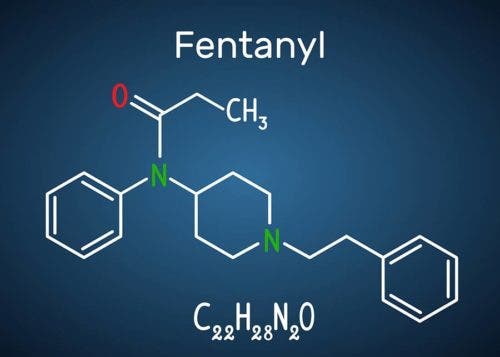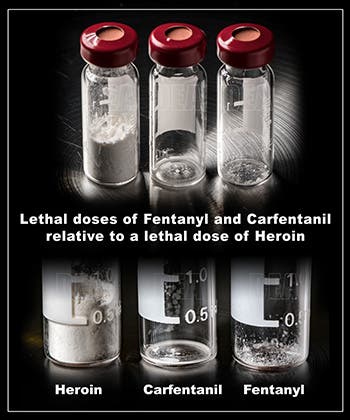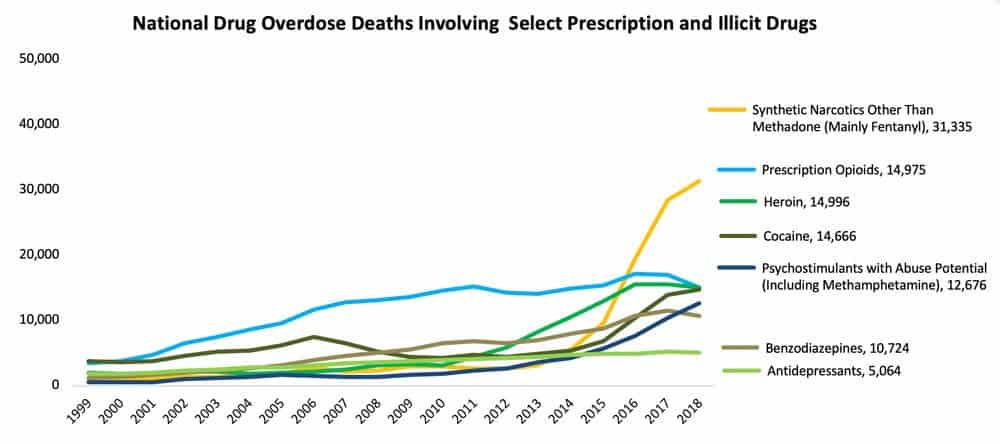Fentanyl is a synthetic opioid that is prescribed for severe, crippling pain — really bad pain since this drug is about 100 times stronger than morphine and 50 times stronger than heroin. Because it’s so strong and cheap to make, in recent years the opioid black market, which was typically dominated by heroin and prescription painkillers, has been flooded with fentanyl or fentanyl-cut products.
However, the line between medicine and poison is very thin with fentanyl. Imagine a dash of salt — if that were fentanyl, it would be enough to kill you.
The low toxicity threshold makes it incredibly easy for people to overestimate the quantity of the substance they’re using and overdose. But most of the time people are not even aware that they are taking fentanyl as the drug is often cut into other substances to make them stronger.
According to researchers at the Centers for Disease Control and Prevention (CDC), as of 2018 fentanyl is officially the deadliest drug in the United States.

Official data from 2016 shows that nearly 63,000 people died of drug overdose in the United States that year. Fentanyl was involved in nearly 29% of those cases, while heroin came in second with 25% and methamphetamine was third at a rate of over 10%. What’s staggering is that in 2011, fentanyl was responsible for only 4% of overdoses. Between 2013 and 2016, overdoses from fentanyl rose 113% a year.
Since 2015, the U.S. has lost more than $2.5 trillion due to the opioid crisis.
How is fentanyl used?

Fentanyl was first developed in 1959 and is commonly used in multiple avenues of healthcare, most commonly for chronic pain management and in surgical settings under the guidance of an anesthesiologist. It is typically used in patients under great pain who are already tolerant to opioids, such as morphine.
Fentanyl pharmaceutical products come in many forms, including effervescent buccal tablets (Fentora), sublingual tablets (Abstral), sublingual sprays (Subsys), lollipops (Actiq), nasal sprays (Lazanda), skin patches (Duragesic), and injectable formulations.
But although fentanyl is prescribed in legitimate pharmaceutical varieties, most users procure illicit versions of the drug smuggled from China through the US postal service and Mexican drug cartels. Most often, smuggled fentanyl comes in the form of a white powder. Alternatively, the drug is dropped onto blotter paper, put in eye droppers and nasal sprays, or made into pills that look indistinguishable from other prescription opioids.
Part of the problem behind fentanyl being so difficult to control lies in its chemical composition, which makes it easy and cheap to reproduce by street chemists. Most of the fentanyl associated with recent overdoses is made in clandestine labs.
Many drug dealers mix fentanyl with other illicit street drugs, such as heroin, cocaine, methamphetamine, and MDMA. Fentanyl triggers an intense high for very little money, so there’s an economic incentive to use it to dope other drugs. However, if users are not made aware they are taking fentanyl, they may risk taking stronger opioids than their bodies are accustomed to, making an overdose more likely.
How does fentanyl affect the body?
Like any other opioid, fentanyl molecules bind to the body’s opioid receptors, which are mostly concentrated in areas of the brain responsible for controlling pain and emotions.
When the fentanyl binds to these receptors, it increases dopamine levels in the brain’s reward centers and produces an intense state of euphoria and relaxation.
Some of fentanyl’s effects include:
- extreme happiness and euphoria
- drowsiness
- nausea
- confusion
- constipation
- sedation
- problems breathing
- unconsciousness
Due to its extremely high potency, fentanyl is also highly addictive. Those who are addicted to the opioid and stop using it can experience severe withdrawal symptoms that begin as early as a few hours after the drug was last taken. These withdrawal symptoms include:
- muscle and bone pain
- sleep problems
- diarrhea and vomiting
- cold flashes with goosebumps
- uncontrollable leg movements
- severe cravings
What are common street names for fentanyl?
Fentanyl goes by many names, including Apache, China Girl, China Town, Dance Fever, Friend, TNT, Goodfellas, Great Bear, He-Man, Jackpot, King Ivory, Murder 8, and Tango & Cash.
What makes fentanyl so dangerous?
When used appropriately, fentanyl is a very effective pain mitigator for those who have grown a high tolerance to opioids, such as cancer patients who have been taking painkillers for years.
But fentanyl not only binds to receptors in the brain’s reward centers but also to those located in other areas of the brain, including those that control breathing. So although fentanyl produces a very potent high, it can also cause difficulties breathing that can potentially lead to death.
This is a problem that is caused by heroin too, as well as other opioids, but fentanyl is particularly dangerous because its chemical makeup allows it to enter opioid receptors much faster than heroin.
What’s more, fentanyl also adheres more tightly to the opioid receptor than other opioids. This means that only a small amount is enough to catalyze the molecular chain of events that initiates the opioid’s effects on the body.
This explains why even less than a milligram of fentanyl can trigger an overdose in a user with no tolerance.

Naloxone is a medicine that can be given to a person to reverse a fentanyl overdose. Multiple naloxone doses might be necessary because of fentanyl’s potency.
Can fentanyl be stopped in the future?
According to the latest drug overdose death data from the National Institute of Drug Abuse (NIDA), 68,000 people in the United States were killed by prescription opioid painkillers and other drugs in 2018. That’s a kill rate higher than the peak annual deaths from car crashes, AIDS, or guns — combined.
On the bright side, 2018 was the first year since 1990 that drug overdoses have declined, a 5% reduction relative to 2017.
Experts in addiction and law enforcement say that the overall drop in deaths to overdoses can be pinned to tighter regulations of opioid prescriptions. In 2016, Massachusetts became the first state in the nation to pass a law that limits opioid prescriptions to 7 days. Since then, over half of all states have enacted laws that restrict the prescribing or dispensing of opioids for acute pain.
However, while prescription opioid overdoses have fallen considerably since 2016, deaths attributed to synthetic narcotics, which includes fentanyl, are still on the rise.

From 2012 to 2018, the number of drug overdose deaths involved fentanyl or fentanyl analogs increased nearly 12-fold.
There’s no clear-cut solution to the rise of fentanyl or synthetic opioids in general. And as if fentanyl wasn’t scary enough, an analog called carfentanil is also creeping up in the illicit drug market. Carfentanil is 100 times stronger than fentanyl and is normally used as a sedative for large animals such as elephants. It’s so dangerous that some countries, the U.S. included, have described it as a ‘chemical weapon’ and have prepared contingency plans in the face of its potential use in war.
In order to curb the opioid epidemic, both the Obama and Trump administrations have attempted to persuade Chinese authorities to crack down on the supply of fentanyl from China to the United States. These efforts seem to have paid off as China announced in April 2019 that the production, sale, and export of fentanyl and all its analogous products are prohibited, except for some authorized firms that have been granted special licenses.
However, it remains to be seen the degree to which these rules can be enforced. It’s believed there are hundreds of thousands of chemical and pharmaceutical facilities in China, which would make the challenge of enforcing fentanyl production laws formidable. What’s more, policy experts at Brookings claim that China has a history of downplaying narcotics problems, so it will be unlikely to mount counternarcotics cooperation with the United States unless it starts experiencing its own synthetic opioid epidemic. Strained U.S.-China relations add further uncertainty.



